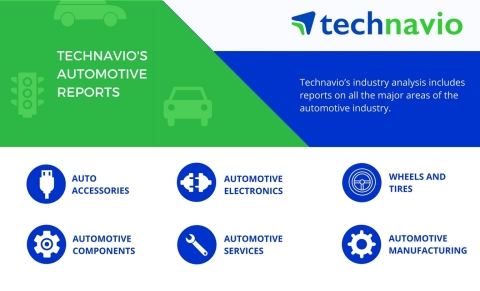LONDON--(BUSINESS WIRE)--Technavio’s latest market research report on the global automotive engine oil cooler market is expected to grow at a CAGR of close to 11% during the period 2017-2021. It also provides an analysis of the most important trends expected to impact the market outlook from 2017-2021. Technavio defines an emerging trend as a factor that has the potential to significantly impact the market and contribute to its growth or decline.
One of the key factors resulting in the growth of the automotive engine oil cooler market is that the engine oil cooler can maintain the oil's lubricating quality for longer periods by keeping up the optimum working temperature.
This report is available at a USD 1,000 discount for a limited time only: View market snapshot before purchasing
Buy 1 Technavio report and get the second for 50% off. Buy 2 Technavio reports and get the third for free.
The top three emerging market trends driving the global automotive engine oil cooler market according to Technavio research analysts are:
- Use of performance engine oil coolers in drag races
- Increasing demand for lightweight and compact engine oil coolers
- Development of electronic grille shutters and heat flux sensors
Looking for more information on this market? Request a free sample report
Technavio’s sample reports are free of charge and contain multiple sections of the report including the market size and forecast, drivers, challenges, trends, and more.
Use of performance engine oil coolers in drag races
Better designs and configurations in internal combustion engines have revived the racing industry. From engines to the aerodynamics to the chassis, drivetrain, and others, drag racers look for ways to optimize their cars. Racers often overlook engine oil cooler which is one of the most important components in a race car. In modern racing cars, because of high-performance, engine oil coolers can manage the excessive heat dissipation. Also, it can control the thermal balance of the car, thus improving the engine efficiency.
According to Ganesh Subramaniam, a lead analyst at Technavio for automotive components “An engine oil cooler can be customized according to the specific racing application. It is critical to optimizing the performance of the race car. Based on customer specification of their engine, chassis, tires, and performance goals, it allows the engine to operate at predetermined RPM and load range. One of the key advantage in a drag racing vehicle is the proper heat dissipation achieved by engine oil cooler, especially during vigorous driving.”
Increasing demand for lightweight and compact engine oil coolers
Engine oil cooler is a heat exchanger whose primary function is to remove excess heat from the engine to prevent the wear and tear of the engine and its parts. Radiator, water pump, electric cooling fan, radiator pressure cap, engine oil cooler, and thermostat are the constituents of an automotive cooling system. Out of these components, the engine oil cooler is the most prominent part of the cooling system in high-performance vehicles.
Coolant keeps on rotating around the engine's cylinder and while rotating it accumulates heat. The thermostat triggers a valve attached to it which allows the coolant to flow through the radiator, when the temperature of the coolant rises above the threshold value. When the coolant flows through radiator tube, the excess heat is dissipated and cools down the coolant, and again coolant starts revolving around the engine cylinder. Currently, the downsized engines tend to get heated soon as it creates more power from a very small displacement engine. Such engines require efficient engine oil coolers so that heat can dissipate faster and efficiently.
Development of electronic grille shutters and heat flux sensors
Electronic grille shutters automatically close and open the front grille to allow airflow into the engine and reduce the heat formed in the powertrain. To reduce the amount of aerodynamic drag, the electronic sensors of the front grille regulate the extent of opening. To support the aerodynamic features of the vehicles and aid in increasing fuel efficiency, the front grilles are usually sealed in commercial vehicles. Electronic grille shutters will prove to be an important addition to the thermal management systems in commercial vehicles.
“Accurate investigation of the thermal state of the engine is possible with the development of new heat flux sensors. Heat flux is the intensity of heat flow through a unit area per unit of time. During various operations and engine loads, heat flux is detected by sensors in the vehicle powertrain. This information allows OEMs to understand the effectiveness of their thermal management systems,” says Ganesh.
Browse Related Reports:
- Global Automotive Active Engine Mount Market 2017-2021
- Global Automotive Power Steering Gears Market 2017-2021
- Global Hybrid Electric Vehicle Conversion Kit Market 2017-2021
About Technavio
Technavio is a leading global technology research and advisory company. Their research and analysis focuses on emerging market trends and provides actionable insights to help businesses identify market opportunities and develop effective strategies to optimize their market positions.
With over 500 specialized analysts, Technavio’s report library consists of more than 10,000 reports and counting, covering 800 technologies, spanning across 50 countries. Their client base consists of enterprises of all sizes, including more than 100 Fortune 500 companies. This growing client base relies on Technavio’s comprehensive coverage, extensive research, and actionable market insights to identify opportunities in existing and potential markets and assess their competitive positions within changing market scenarios.
If you are interested in more information, please contact our media team at media@technavio.com.




